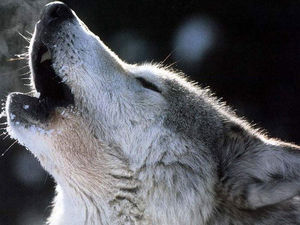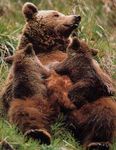Le second enfant loup de Sultanpur
Voici un extrait de A Journey through the Kingdom of Oude. Je
n’ai vraiment pas le courage de traduire pour l’instant.
In all
parts of India, the Hindoos have a notion that the family of a man who kills a
wolf, or even wounds it, goes to utter ruin; and so also the village within the
boundaries of which a wolf has been kille d or wounded... Some Rajpoot families
in Oude, where so many children are devoured by wolves, are getting over this
prejudice.
d or wounded... Some Rajpoot families
in Oude, where so many children are devoured by wolves, are getting over this
prejudice.
There is
now at Sultanpoor a boy who was found alive in a wolf's den, near Chandour,
about ten miles from Sultanpoor, about two years ago. A trooper sent by the
native governor of the district of Chandour, to demand payment of some revenue,
was passing along the bank of the river near Chandour about noon, when he saw a
large female wolf leave her den, followed by three whelps and a little boy. The
boy went on all fours and seemed to be on the best possible terms with the old
dam and the three whelps, and the mother seemed to guard all four with equal
care. They all went down to the river and drank without perceiving the trooper,
upon his horse watching them. As soon as they were about to turn back, the
trooper pushed on to cut off and secure the boy; but he ran as fast as the
whelps could, and kept up with the old one. The ground was uneven, and the
trooper's horse could not overtake them.
They all
entered the den, and the trooper assembled some people from Chandour with
pick-axes, and dug into the den. When they had dug in about six or eight feet,
the old wolf bolted with her three whelps and the boy.
The trooper
mounted and pursued, followed by the fleetest young men of the party; and as
the ground over which they had to fly was more even, he headed them and turned
the whelps and the boy back upon the men on foot, who secured the boy and let
the old dam and the three cubs go on their way.
They took
the boy to the village but had to tie him for he was very restive, and
struggled hard to rush into every hole or den they came near. They tried to
make him speak, but could get nothing from him but an angry growl or snarl. He
was kept for several days at the village, and a large crowd assembled every day
to see him. When a grown-up person came near him, he became alarmed, and tried
to steal away; but when a child came near him, he rushed at it, with a fierce
snarl like that of a dog, and tried to bite it. When any cooked meat was put
before him, he rejected it in disgust; but when any raw meat was offered, he
seized it with avidity, put it on the ground under his paws, like a dog, and
ate it with evident pleasure. He would not let anyone come near him while he
was eating, but made no objection to a dog coming and  sharing his food with
him. The trooper remained with him four or five days, and then returned to the
governor, leaving the boy in charge of the Rajah of Hasunpoor. He related all
that he had seen, and the boy was soon after sent to the European officer
commanding the First Regiment of Oude Local Infantry at Sultanpoor, Captain
Nicholetts, by order of the Rajah of Hosunpoor, who was at Chandour, and saw
the boy when the trooper first brought him to that village. This account is
taken from the Rajah's own report of what had taken place.
sharing his food with
him. The trooper remained with him four or five days, and then returned to the
governor, leaving the boy in charge of the Rajah of Hasunpoor. He related all
that he had seen, and the boy was soon after sent to the European officer
commanding the First Regiment of Oude Local Infantry at Sultanpoor, Captain
Nicholetts, by order of the Rajah of Hosunpoor, who was at Chandour, and saw
the boy when the trooper first brought him to that village. This account is
taken from the Rajah's own report of what had taken place.
Captain
Nicholetts made him over to the charge of his servants, who take great care of
him, but can never get him to speak a word. He is very inoffensive except when
teased, Captain Nicholetts says, and will then growl surlily at the person who
teases him. He had come to eat anything that is thrown to him, but always
prefers raw flesh, which he devours most greedily.
He will
drank a whole pitcher of buttermilk when put before him, with I out seeming to
draw breath. He can never be induced to keep on any kind of clothing even in
the coldest weather. A quilt stuffed with cotton was given to him when it
became very cold this season, but he tore it to pieces, and ate a portion of it
cotton and all, with his bread every day. He is very fond of bones,
particularly uncooked ones, which he masticates apparently with as much ease as
meat. He has eaten half a lamb at a time without any apparent effort, and is
very fond of taking up earth and small stones and eating them. His features are
coarse, and his countenance repulsive; and he is very filthy in his habits. He
continues to be fond of dogs and jackals, and all other small four-footed
animals that come near him; and always allows them to feed with him if he
happens to be eating when they approached.
Captain
Nicholetts in letters dated the 14th and 19th of September, 1850, told me that
the boy died in the latter end of August, and that he was never known to laugh
or smile. He understood little of what was said to him, and seemed to take no
notice of what was going on around him.
He formed
no attachment for anyone, nor did he seem to care for anyone.
He never
played with any of the children around him, or seemed anxious to do so. When
not hungry he used to sit petting and stroking a pareear or vagrant dog, which
he used to permit to feed out of the same dish with him. A short time before
his death Captain Nicholetts shot this dog, as he used to eat the greater part
of the food given to the boy, who seemed in consequence to be getting thin. The
boy did not seem to care in the least for the death of the dog. The parents
recognized the boy when he was just found, Captain Nicholetts believes; but
when they found him to be so stupid and insensible, they left him to subsist
upon charity. They have now left Hasunpoor, and the age of the boy when carried
off cannot be ascertained; but he was to all appearances about nine or ten
years of age when found, and he lived about three years afterwards. He used
signs when he wanted anything, and very few of them except when hungry, and he
then pointed to his mouth. When his food was placed at some distance from him,
he would run to it on all fours like any four-footed animal; but at other times
he would Falk upright occasionally. He shunned human beings of all kinds, and
would never willingly remain near one. To cold, heat, and rain he appeared to
be indifferent; and he seemed to care for nothing but eating. He was very
quiet, and required no kind of restraint after being brought to Captain Nicholetts.
He had lived with Captain Nicholetts' servants about two years, and was never
heard to speak till within a few minutes of his death, when he put his
wolf-children hands to his head and said, "It ached," and asked for
water. He drank it and died.
the boy when he was just found, Captain Nicholetts believes; but
when they found him to be so stupid and insensible, they left him to subsist
upon charity. They have now left Hasunpoor, and the age of the boy when carried
off cannot be ascertained; but he was to all appearances about nine or ten
years of age when found, and he lived about three years afterwards. He used
signs when he wanted anything, and very few of them except when hungry, and he
then pointed to his mouth. When his food was placed at some distance from him,
he would run to it on all fours like any four-footed animal; but at other times
he would Falk upright occasionally. He shunned human beings of all kinds, and
would never willingly remain near one. To cold, heat, and rain he appeared to
be indifferent; and he seemed to care for nothing but eating. He was very
quiet, and required no kind of restraint after being brought to Captain Nicholetts.
He had lived with Captain Nicholetts' servants about two years, and was never
heard to speak till within a few minutes of his death, when he put his
wolf-children hands to his head and said, "It ached," and asked for
water. He drank it and died.


/https%3A%2F%2Fprofilepics.canalblog.com%2Fprofilepics%2F3%2F8%2F381624.jpg)
























